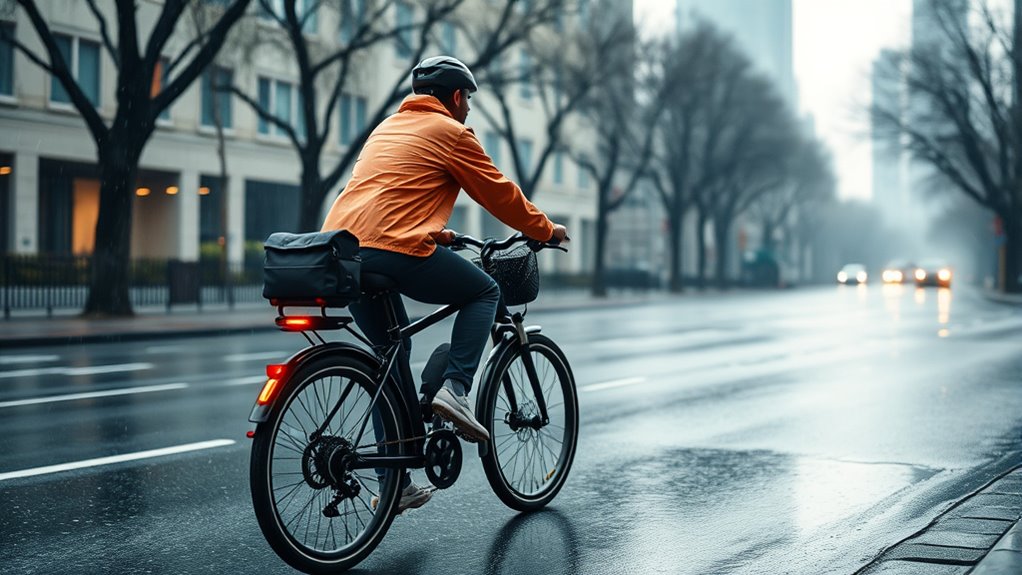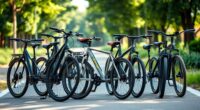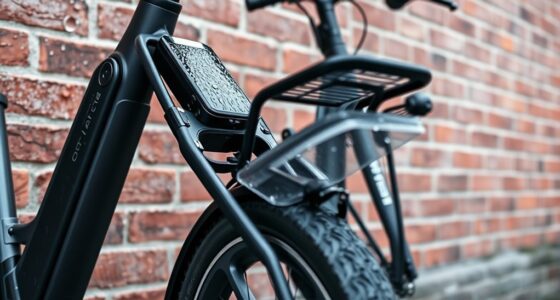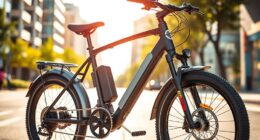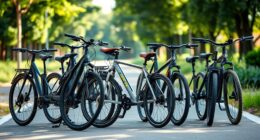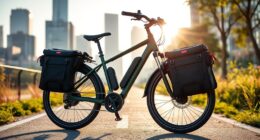To plan a seamless e-bike commute in bad weather, start by investing in waterproof, breathable gear and moisture-wicking layers to stay dry and comfortable. Choose routes that avoid flooding, heavy traffic, and slick surfaces, and check weather forecasts regularly to adjust plans accordingly. Equip your bike with bright lights and reflective gear to stay visible, ride at a cautious pace, and stay alert to changing conditions. Keep these tips in mind, and you’ll be better prepared to tackle bad weather safely.
Key Takeaways
- Check weather forecasts regularly and adjust your route or delay rides accordingly.
- Choose well-maintained, bike-friendly paths away from flood-prone areas and heavy traffic.
- Equip your e-bike with bright lights, reflectors, and wear high-visibility gear for better visibility.
- Wear waterproof, breathable gear and moisture-wicking layers to stay dry and comfortable.
- Slow down, increase following distance, and ride cautiously at intersections and slick surfaces.
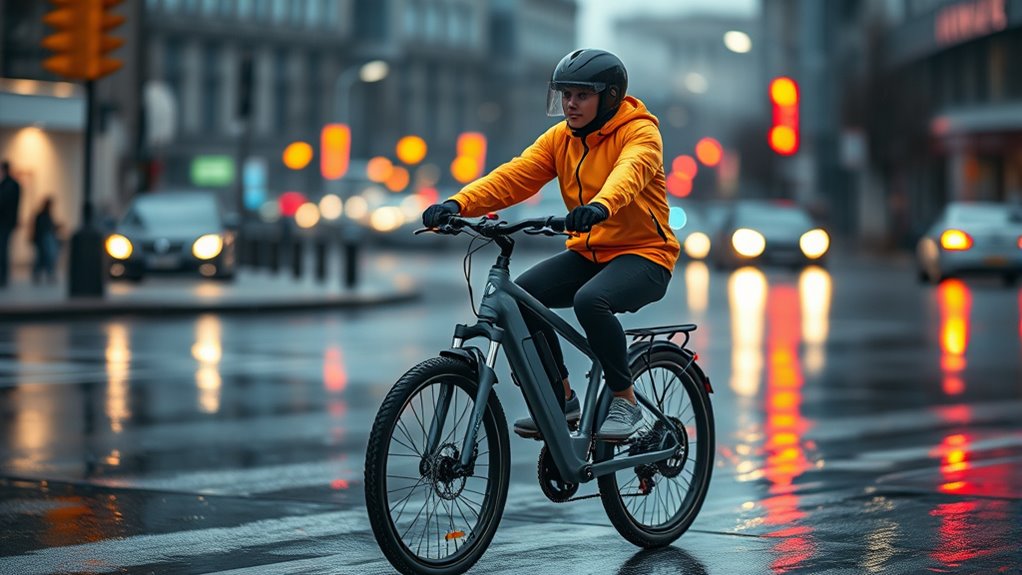
Commuting by e-bike in bad weather can be challenging, but with proper planning, you can stay dry, safe, and on time. Your first step is to think about rain gear. Investing in a good waterproof jacket, pants, and shoe covers can make a huge difference. Look for breathable fabrics to prevent overheating, and don’t forget a waterproof helmet cover or a hat under your helmet to keep your head dry. Wearing moisture-wicking base layers helps manage sweat and keeps you comfortable, even if you get caught in a downpour. Carrying a lightweight, packable rain poncho can be a lifesaver if the rain intensifies suddenly. Your goal is to stay dry without sacrificing mobility or comfort.
Once you’ve got your rain gear sorted, focus on route planning. Bad weather demands extra caution, so choose a route that minimizes exposure to heavy traffic, flooded areas, or narrow, poorly lit paths. Stick to well-maintained, bike-friendly roads or dedicated bike lanes whenever possible. Use navigation apps that highlight bike routes, and consider avoiding routes with lots of stop-and-go traffic, which can be more hazardous when visibility is reduced. If your usual route includes areas prone to flooding, identify alternative pathways beforehand. Take note of any underpasses or low-lying areas that flood easily, and plan to bypass them during heavy rain. It’s also wise to check weather forecasts regularly so you can adjust your commute if conditions worsen unexpectedly. If a route becomes too hazardous, don’t hesitate to alter your plan or delay your trip if possible. Additionally, understanding how contrast ratio affects your visibility can help you select the most suitable lighting conditions for safe riding in poor weather.
Lighting and visibility are critical in bad weather, so equip your e-bike with bright front and rear lights. Ensure they’re functioning well and turn them on early, even during daylight hours, to enhance your visibility. Wear reflective clothing or accessories, and consider attaching reflective tape to your bike. These simple steps help drivers and other road users see you clearly, reducing the risk of accidents. When riding in rain or fog, slow down and increase your following distance. Wet roads can be slippery, and reduced visibility means you need more time to react to obstacles or sudden stops. Keep your hands dry and maintain a firm grip on the handlebars to prevent slipping. Be extra cautious at intersections and crosswalks, where slick surfaces can cause skidding.
Frequently Asked Questions
How Can I Prevent My E-Bike From Freezing in Cold Temperatures?
To prevent your e-bike from freezing in cold temperatures, you should focus on maintaining tire traction and staying alert to road hazards. Keep your tires properly inflated and consider using winter-specific tires for better grip. Wipe off any snow or ice from your bike regularly, and ride cautiously, especially on icy patches. Being aware of potential road hazards helps you avoid slipping or losing control, ensuring a safer, more comfortable ride.
What Should I Wear for Visibility During Rainy or Foggy Rides?
When riding in rainy or foggy conditions, you should wear reflective clothing to boost your visibility. Pair this with bright LED lights on your bike and helmet to guarantee you’re seen from all angles, especially in low-light situations. Consider waterproof gear to stay dry and comfortable. These safety measures help you stay visible to others, reducing the risk of accidents and making your ride safer and more enjoyable despite the bad weather.
How Do I Protect My E-Bike’S Electronic Components From Water Damage?
To protect your e-bike’s electronic components from water damage, you should invest in waterproofing accessories like waterproof bags and covers. Additionally, use electronic component safeguards such as sealants or protective sprays on exposed parts. Regularly inspect and maintain your bike’s wiring and connectors to make sure they stay dry and functional. Taking these precautions helps keep your e-bike safe and reliable, even in challenging weather conditions.
What Are the Best Storage Options for My E-Bike During Bad Weather?
Did you know that 60% of e-bike owners report damage due to poor storage? To protect your e-bike in bad weather, use a sturdy bike lock and store it in a weatherproof storage shed or a secure garage. These options keep your bike safe from rain, snow, and theft. Make sure your storage area is dry, ventilated, and away from harsh elements for the best protection.
How Can I Maintain Battery Performance in Cold or Wet Conditions?
To maintain your e-bike battery in cold or wet conditions, guarantee proper battery insulation to prevent cold damage and optimize performance. Keep your tires with good traction to avoid slips on wet surfaces, especially in slippery conditions. Regularly check and dry your battery connections after rides in rain. By insulating your battery and maintaining tire traction, you’ll extend battery life and stay safe during your commute in challenging weather.
Conclusion
By preparing ahead and choosing the right gear, you can turn even the gloomiest, stormy days into a smooth ride. Remember to stay alert and adapt to changing conditions, just like a seasoned knight maneuvering treacherous terrain. With a little foresight, your e-bike commute becomes as effortless as a stroll through a well-manicured garden, no matter the weather. So, gear up, stay safe, and let the elements be no match for your journey.
